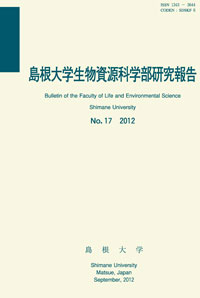島根大学生物資源科学部
ISSN:2435-0885(online)
ISSN:1343-3644(in print)
A publication of this bulletin in print format has not been made since no 24.
ISSN:1343-3644(in print)
A publication of this bulletin in print format has not been made since no 24.

number of downloads : ?
Use this link to cite this item : https://ir.lib.shimane-u.ac.jp/48779
Bulletin of the Faculty of Life and Environmental Science Shimane University 24
2019-11-30 発行
Suppression effects of a secondary metabolite of Biscogniauxia sp. strain O-811 obtained from mushrooms against the rice blast fungus Magnaporthe oryzae
Description
Rice blast disease, caused by Magnaporthe oryzae, is considered the most important fungal disease of rice worldwide. Owing to continuous resistance acquisition, several fungicide chemicals are no longer effective. Therefore, there is a need to identify natural components for the development of new agents for the control of fungal pathogens. In the present study, we evaluated the antifungal activity of an ethyl acetate extract of the culture filtrates (ECF) of strain O-811 isolated from the fresh fruiting bodies of wild mushrooms against the rice pathogen M. oryzae. When conidia of M. oryzae were suspended in O-811-ECF and dropped onto glass slides, conidia germination was significantly inhibited in a dose-dependent manner. Additionally, the length of blast lesions produced by M. oryzae was significantly reduced in the presence of O-811-ECF compared to distilled water. Internal transcribed spacer region sequence analysis indicated that this isolate (O-811) shared similarities with the fungal species of Biscogniauxia sp. The growth inhibition zone against M. oryzae in the presence of O-811-ECF was observed at Rf 0.66 on the thin layer chromatography (TLC) plate. Furthermore, the growth inhibition zone by O-811-ECF and{(3aS,4aR,8aS,9aR)-3a-hydroxy-8a-methyl-3,5-dimethylenedecahydronaphto[2,3-b]fu ran-2(3H)-one} (HDFO) was detected with the same Rf value on TLC plates. These results suggest that the inhibitory compound included in the strain of the O-811 isolate of Biscogniauxia sp. is the same as that from the HDFO of strain O-821.
About This Article
Other Article
PP. 9 - 13
